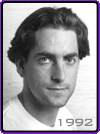Articles

LucasArts.com 20th Anniversary Developer Profiles Jon Knoles
We are pleased to present the first in our series of LucasArts profiles -- an interview series with some of the people who have made LucasArts the company that it is today. This first piece profiles Jon Knoles, who has been with the company for 12 years -- beginning with work on the early games for the Nintendo Entertainment System. Jon is now leading the development effort for LucasArts' forthcoming Star Wars®: Bounty Hunter™ game for PlayStation®2 and GameCube™.
Jon Knoles Director
Game History:
2002
Star Wars®: Bounty Hunter™ (PlayStation2, GameCube)Director/Writer/Game Designer
1999
Star Wars: Episode I Racer™ (PC-CDROM)Game Designer, Co-Project Leader, and Lead Artist
Star Wars: Episode I Racer (Nintendo 64)
Game Designer, Co-Project Leader, and Lead Artist
1997
Star Wars: Shadows of the Empire® (PC-CDROM)Game Designer, Co-Project Leader, and Lead Artist
1996
Star Wars: Shadows of the Empire (Nintendo 64)Game Designer, Co-Project Leader, and Lead Artist
1995
Star Wars: Rebel Assault® II (PC-CDROM)3D modeling/animation, level design
1994
Star Wars: TIE Fighter®: Defender of the Empire® (PC)2d and 3D art and animation, cinematic scenes
Star Wars TIE Fighter (PC)
2D and 3D cinematic art and animation
Star Wars: X-Wing®: Imperial Pursuit® (PC)
2D and 3D cinematic art and animation
Super Return of the Jedi™(SNES)
Lead animator/level and cinematic artist
1993
Super Empire Strikes Back™ (SNES)Lead animator/level and cinematic artist
Star Wars: X-Wing: B-Wing® (PC)
2D and 3D cinematic art and animation
Indiana Jones' Greatest Adventures™ (SNES)
Lead Animator
1992
Super Star Wars (SNES)Lead animator, level and cinematic artist
X-Wing (PC)
Artist/Animator: cockpit, cinematic, special effects art
1991
The Empire Strikes Back™ (8-bit NES)Level and cutscene artist
Star Wars (8-bit NES)
Animator, cutscene and level artist
1990
Defenders of Dynatron City® (8-bit NES)Animator, background artist
LucasArts.com: How did you first get into game development?
Jon Knoles: After I graduated from the Art Institute of Seattle I had a bunch of lame jobs. Then one day I got a call from a placement office to work at Taito Software. Working in game development wasn't really a career plan for me. I was intending on working in industrial design or advertising.
LucasArts.com: What brought you to LucasArts?
Jon Knoles: In 1990 I was laid off from Taito Software in Seattle after working on Indiana Jones® and the Last Crusade™ for the 8-bit Nintendo Entertainment System (NES). I heard through our Lucasfilm Games connections that they might be looking for artists in the "video games" group. I sent my reel and portfolio and they said, "You can come on down if you want to." It was very nonchalant. There were no airplane tickets or hotels in those days. So, I jumped in my Beetle and drove the 13 plus hours to sleep on a friend's floor while I worked for a week doing backgrounds for NES games. They said I could stay.
LucasArts.com: What was the company like when you started?
Jon Knoles: Lucasfilm Games was small when I started; I would say we were a total of less than 40 people. The video games group was only 8 or 10 people. We were the only ones from the Games Group left at the Ranch--everybody else had moved to an office in San Rafael. I felt kind of privileged. Back then, the video games group was working on Defenders of Dynatron City® and Star Wars® for NES. The rest of Lucasfilm Games was developing SCUMM games like The Secret of Monkey Island® and The Dig®.
LucasArts.com: What was your first project/job?
Jon Knoles: My first job was as a background artist on Defenders of Dynatron City for the NES. That rapidly turned into background artist, effects artist, and animator. And then I found myself working on Star Wars NES at the same time, doing pretty much the same stuff.
LucasArts.com: How did you progress into the role you are in today?
Jon Knoles: I was an artist for the company until the mid-90's when I became the only original member of the video games group left. When the company began the development of a Nintendo 64 game, I was asked to share leadership of the project. From then on I was a Project Leader, Game Designer, and Lead Artist until my most recent project where I took on my first solo Directorship.
LucasArts.com: Describe your role in the game development process.
Jon Knoles: As a Director, you supply the vision for the game. Developing a game is truly a collaborative effort, but it is not a democracy. The Director has to make the major decisions.
LucasArts.com: What are you working on now?
Jon Knoles: Right now I am the Director for Star Wars Bounty Hunter. I got started on this project after Simon Jeffery, the President of LucasArts, asked me to lead the development of a Star Wars Episode II game. We all knew it was time to do a game featuring Jango Fett.
Jango is a perfect game character because he looks cool, he has a questionable moral center, and he is a one-man army equipped with gadgets and weapons like a missle-firing jetpack and dual blaster pistols. Jango is going to help infuse some new attitude into Star Wars games.
Star Wars Bounty Hunter isn't going to just be a game where you play the movie; the player will get to explore and find the answers to the unanswered questions from Star Wars Episode II like why Jango was chosen to be the template for a Clone army, where the Slave 1 came from, and why Jango wanted a son. There also will be new characters introduced in the game that are not in the movie. A twisted, deranged Jedi who is Jango's prey, a female Toydarian named Rozatta who helps to guide Jango, and Montross, Jango's archrival will all help to drive the game's storyline.
LucasArts.com: Which is your favorite LucasArts game and why?
Jon Knoles: Star Wars: X-Wing® is my favorite, because I worked really hard on it and was shocked at how good the game turned out. As an artist on the small development team for X-Wing, I did the cut-scenes, cockpits, and special effects, chose the game engine colors, did some of the animation, and designed a few of the missions. This game was the first one that I worked on that truly floored me. This was the first time a space simulation felt like a World War II sim and it was very kinetic. Since Larry Holland had done three really good flight sims, he knew how to make them fun. The main problem with X-Wing was that it was way too difficult for most people. TIE Fighter®, the sequel to X-Wing, did a better job of guiding the player through the game and also allowed for people to play the bad guys.
LucasArts.com: If you could be any character from a LucasArts game which would you be and why?
Jon Knoles: I would be Jango Fett because he won't take crap from anybody.
LucasArts.com: What is the most exciting accomplishment the company has made in its 20 year- long history?
Jon Knoles: We stayed in business, and continued to deliver excellent console and PC games while most other game companies of similar size and stature have fallen away. We've made it this far for a couple of reasons. For one, we're not a public company and we have an extremely patient benefactor who has always given us the necessary time to adapt and grow. Also, we have picked the right moments to take action. We were there when CD-ROM games and console games first started being developed. And since then we've continued to make games for a diversity of platforms.
LucasArts.com: What is your favorite LucasArts moment (relating either to a game or a game's development)?
Jon Knoles: My favorite moment happened in 1992 when I was working part-time on X-Wing at LucasArts and part-time for Larry Holland out of a funky 70's house in Fairfax. The first time we got TIE fighters to fly at the camera firing their trademark green lasers I nearly wet my pants.

